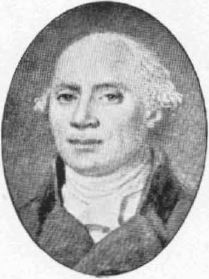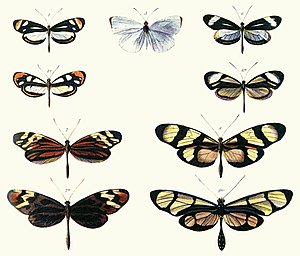Johann Nepomuk von Laicharting was an Austrian entomologist. He was born in Innsbruck on 4 February 1754 and died in the same city on 7 May 1797, and was a Professor of Natural Science (Naturgeschichte) in Innsbruck. He described new species and genera of Coleoptera in Verzeichniss und Beschreibung der Tyroler-Insecten. 1. Teil. Kaferartige Insecten. 1. Band. 1781: I-XII, 1-248. - Zurich, bey Johann Casper Fuessly 1781. In English, lists and descriptions of Tyrol insects - beetles. Presumably this was intended to cover all Austrian insects but no further parts were published.

Christoph Gottlieb von Murr was a polymathic German scholar, based in Nuremberg. He was a historian and magistrate. He edited and contributed to significant cultural and scientific journals. A notable naturalist von Murr was a Member of the Gesellschaft Naturforschender Freunde zu Berlin and the Bayerische Akademie der Wissenschaften. He was also an art historian ,the author of the first bibliography of books on painting, sculpture, and engraving. He published extensively on illuminated manuscripts, early printed books, the history of libraries, the history of the Jesuit missions, the history of the Jews in China, Arabic and Chinese literature. Familiar with most of the European languages, he was an active correspondent with many of the most distinguished scholars of the period. He had a vast library.

Edward Doubleday was an English entomologist primarily interested in Lepidoptera. He is best known for The Genera of Diurnal Lepidoptera: Comprising Their Generic Characters, a Notice of Their Habits and Transformations, and a Catalogue of the Species of Each Genus, co-written with John O. Westwood, and illustrated by William Chapman Hewitson; and List of the Specimens of Lepidopterous Insects in the Collection of the British Museum.
Jakob Heinrich Laspeyres was a German entomologist especially interested in Lepidoptera. He was a Bürgermeister in Berlin. Laspeyres collection is in Museum für Naturkunde.
Walther Hermann Richard Horn was a German entomologist who specialised in beetles (Coleoptera). He was born in Berlin, where he also died. He is not to be confused with the American entomologist George Henry Horn who also studied Coleoptera.

Sigmund Schenkling was a German entomologist who specialised in Coleoptera.
Josef Emanuel Fischer von Röslerstamm or Josef Fischer von Röslerstamm or Josef Fischer von Rösslerstamm was an Austrian entomologist who specialised in Lepidoptera. He was an industrialist manufacturing macaroni, vermicelli, and other processed foods. He lived in Vienna from 1837. Röslerstamm developed a method system of systematic tables (1834–1842) for the Microlepidoptera and described many new species of these tiny moths. He studied often in the Naturhistorisches Museum with Alois Friedrich Rogenhofer and Josef Johann Mann.
Karl Rost was a German entomologist and insect dealer. From 1886 Rost was an insect dealer (Insekten-Händler) and professional insect collector in Berlin. He collected insects later offered for sale in Spain and Greece. In 1899 he went on an expedition to Siberia and in 1900 -1901 collected in the Caucasus. In 1903 he went to Japan to collect insects for the Swiss collector George Meyer-Darcis after two years in North-West India. Rost described many new species from these regions. Parts of his personal collection are in the Museum für Naturkunde in Berlin and other parts are in the Zoologisch Museum Amsterdam. The rest were privately sold, many to the dealership Staudinger - Bang-Haas.
Franz Ocskay von Ocskö (1775–1851) was a Hungarian entomologist. Freiherr Franz L. B. Ocskay was the son of Major-General Joseph Ocskay von Ocsko (1740–1805). He lived in Sopron (Ödenburg). Franz Ocskay described several new species of grasshoppers.
Johann Gottfried Gottlob Mühlig was a German ornithologist and entomologist.
Charles Le Doux was a German entomologist.
Hugues-Fleury Donzel was a French entomologist specialising in butterflies and moths.
Reinhold Ferdinand Sahlberg was a Finnish naturalist notably specialising in entomology.
Christian Daniel Zenker (1766–1819) was a German entomologist who specialised in Coleoptera. He contributed species descriptions to Georg Wolfgang Franz Panzer's Faunae insectorum germanicae initia. He was Hofmarschall for the Kingdom of Saxony. His collection is held by the Staatliches Museum für Tierkunde, Dresden.

Gabriel Bonsdorff was a Finnish entomologist who specialised in Coleoptera notably Curculionidae.
John Walton was an English entomologist who specialised in Coleoptera especially Curculionidae. His collection is held by the Natural History Museum, London John Walton was educated in first in Knaresborough then in London where he studied Chemistry at the Mathematical Society of Spitalfields, then applying his science to sugar refining in his uncles refinery based in Whitechapel whom he succeeded in that lucrative business. By then wealthy he retired in 1832 to devote himself to entomology. He corresponded with Carl Johan Schönherr, Ernst Friedrich Germar and Louis Alexandre Auguste Chevrolat exchanging specimens with all three.
Daniel Erik (Eric) Næzén, was a Swedish provincial physician, engraver, composer and natural scientist. In his youth Næzén was a founder member, on 13 December 1769, of the Swedish Topographical Society in Skara alongside parish priest and naturalist Clas Bjerkander, Anders Dahl, Johan Abraham, entomologist Leonard Gyllenhaal, chemist Johan Afzelius and Olof Knös. The members reported on plant and animal life, geography, topography, historical monuments and economic life, mostly in the Västergötland area. From 1770, Næzén studied in Uppsala, where in April 1782 he gained his licentiate of medicine. He studied under Carl von Linné. In July 1782 he became a provincial physician in Umeå. As a natural scientist, he contributed entomological papers to the Academy of Sciences journals. And also for the science academy he, from 1796 until his death, made meteorological observations in Umeå. Næzén left a comprehensive collection of insects, plants and minerals. Næzén studied at the Musical Academy in 1773 and was an amateur musician and amateur composer. He was elected as member 124 of the Royal Music Academy on 18 December 1790 and by the Royal Academy of Sciences in 1793.
Georg Ludwig Scharfenberg was a German entomologist and a Lutheran pastor. He was the son of a teacher and was educated at the University of Halle. Scharfenberg published notes on insects in Journal für Liebhaber der Entomologie edited by Ludwig Gottlieb Scriba. He described Paraswammerdamia albicapitella, Operophtera fagata and Bucculatrix bechsteinella(with Bechstein).

Johann Dominikus Schultze was a German doctor and natural scientist.
Sigmund von Hochenwarth was an Austrian botanist and entomologist. von Hochenwarth was a Domherr in Gurk, Carinthia. He described Ibalia leucospoides. He wrote:





